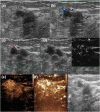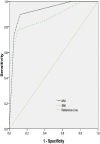Superb microvascular imaging in diagnosis of breast lesions: a comparative study with contrast-enhanced ultrasonographic microvascular imaging
- PMID: 27529640
- PMCID: PMC5124819
- DOI: 10.1259/bjr.20160546
Superb microvascular imaging in diagnosis of breast lesions: a comparative study with contrast-enhanced ultrasonographic microvascular imaging
Abstract
Objective: To evaluate the diagnostic performance of superb microvascular imaging (SMI) in breast lesions, comparing with contrast-enhanced ultrasonographic microvascular imaging (MVI).
Methods: From April to November 2015, 132 patients (with 132 breast lesions) were enrolled in the retrospective study. All lesions were evaluated with colour Doppler flow imaging (CDFI), colour SMI (cSMI), monochrome SMI (mSMI) and contrast-enhanced ultrasonographic MVI. Receiver-operating characteristic curve analysis was performed to compare the diagnostic performance of SMI and MVI for discrimination between benign and malignant breast lesions.
Results: Histological analysis showed 58 malignant and 74 benign lesions. mSMI was more sensitive in detecting blood flow signals in breast lesions than CDFI (p < 0.001) and cSMI (p < 0.001). Differences of vessels inside breast lesions and morphologic features of vessels between benign and malignant lesions were statistically significant on mSMI (p < 0.001). Using root hair-like and crab claw-like patterns as the criteria for malignant lesions, the sensitivity, specificity and accuracy for differentiation based on the microvascular architecture patterns were 77.6, 90.5 and 84.8% for mSMI and 89.6, 87.8 and 88.6% for MVI. Areas under curve of mSMI and MVI were not significantly different (p = 0.129).
Conclusion: mSMI can increase blood flow detection and depict the microvascular architecture of breast lesions. The diagnostic performance of mSMI was not significantly different from MVI. SMI has potential in the differential diagnosis of breast lesions.
Advances in knowledge: mSMI is a non-invasive technique for vascularity evaluation of breast tumours and it is beneficial for breast tumour differentiation.
Figures




References
-
- Less JR, Skalak TC, Sevick EM, Jain RK. Microvascular architecture in a mammary carcinoma: branching patterns and vessel dimensions. Cancer Res 1991; 51: 265–73. - PubMed
MeSH terms
Substances
LinkOut - more resources
Full Text Sources
Other Literature Sources
Medical
Miscellaneous

